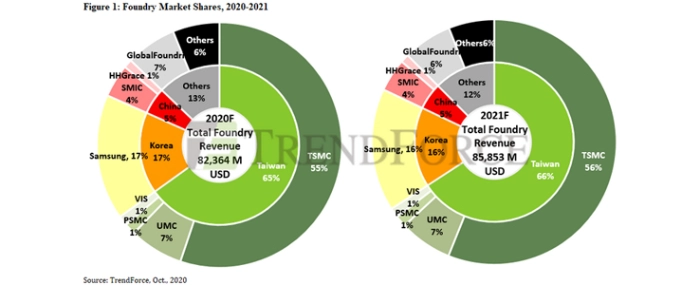
© Trendforce
Analysis |
While close to settling legal case with US, UMC to focus more on foundry business
UMC has announced today (Oct. 22) that the legal case against the company filed by the U.S. Justice Department for stealing trade secrets could now be resolved as soon as possible, according to TrendForce’s latest investigations.
Following close negotiation, both sides appear to have agreed on a reasonable settlement of USD 60 million, meaning the case is likely closing in on a quick resolution, and UMC will be focusing more on its foundry business in the future. At the moment, this resolution is pending on an approval by the court.
The legal case originated from an indictment of intellectual property theft issued by the U.S. Justice Department against the Chinese memory manufacturer JHICC. In May 2016, UMC entered into a technological cooperation agreement with JHICC, which had just been established in February of the same year. Then in November 2018, the U.S. government imposed export restrictions on JHICC to halt the operation of its production plant after announcing that the company was suspected of committing patent infringements. At that same time, the U.S. Justice Department charged UMC for facilitating JHICC in its attempt to illegally acquire Micron’s DRAM manufacturing technology.
Given the current shortage in foundry capacity, whether the tight supply of 8-inch wafer capacity will lead to a wave of M&As and capacity expansions will be key points to watch for
Regarding the recent situation in the foundry market, the emergence of the COVID-19 pandemic and the policy responses to this crisis (e.g. border closures and regional lockdowns) compelled component suppliers and OEMs to aggressively build up their inventories during the early part of 2020. Besides anxieties about disruptions in the semiconductor supply chain, the pandemic has caused a dramatic expansion of the stay-at-home economy. This, in turn, has sustained demand for certain electronic products such as PCs, servers, networking devices, and TVs. Furthermore, the market penetration of 5G smartphones is climbing, and the build-out of 5G infrastructure continues apace. Owing to the above-mentioned factors, foundries have been operating with a capacity utilization rate of 90-100% since 1Q20. It is also worth pointing out that the latest escalations in the U.S.-China trade dispute has led to some reshuffling in the foundry sector. Hence, the supply of available foundry capacity will likely become even tighter in the future.
The production capacity for various manufacturers, including Taiwanese manufacturers TSMC, UMC, Vanguard, and PSMC, South Korean manufacturer Samsung, and Chinese manufacturer SMIC, has been in a short supply status for a prolonged period due to the vigorous demand for PMIC and DDIC in the existing 8-inch wafer market, which has resulted in a price increase for some manufacturers. Regarding 12-inch wafer fabs, the advanced process market led by TSMC and Samsung continues to flourish thanks to high demand for HPC and high-end smartphone chipsets. UMC, ranked fourth in global market shares, currently possesses seven 8-inch wafer fabs and four 12-inch wafer fabs, with a total production capacity of 340K/M (12-inch equivalent). The manufacturer has foregone the development of 14nm and below advanced processes in recent years and instead poured all resources into 28nm and above processes as well as the 8-inch wafer market. UMC’s 28nm capacity is both mature and nearing max load, with a small-scale capacity expansion currently under evaluation.
Assuming that the global economy makes a successful recovery, and the pandemic is brought under control in 2021, TrendForce anticipates that shipments of various end products next year, including servers, smartphones, and notebook computers, will surpass 2020 figures, thereby generating a corresponding high demand for various semiconductor components. Although the outcome of the U.S.-China trade dispute and the pandemic still remains uncertain, these risk factors have also induced foundry clients to keep their component inventory levels high, in turn leading to a continued shortage in foundry capacities, especially for 8-inch wafers. In the short run, new M&As and capacity expansions will become potential developments to watch for in the 8-inch wafer market.



